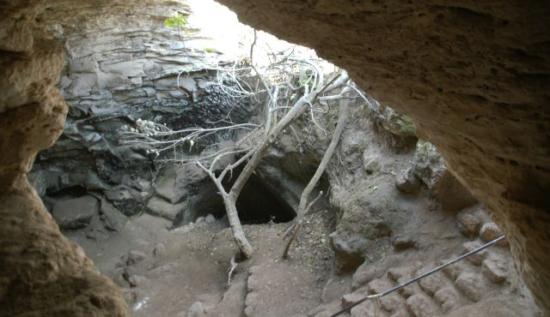The letters presented by Yigael Yadin were signed by Bar Kochba, the man revered by modern Israelis — but who led the Jewish nation to disaster.
David B. Green
Source - http://www.haaretz.com/news/features/this-day-in-jewish-history/1.655964

An entrance into an excavated cave used by Bar Kochba’s rebels. Photo by Udi Steinwell / Wikimedia Commons
On May 12, 1960, archaeologist Yigael Yadin, appearing at the Jerusalem residence of President Yitzhak Ben-Zvi, announced the astounding discovery of a cache of 2,000-year-old letters.
The letters had been signed by the legendary Jewish warrior Shimon Bar Kochba, leader of a devastating second-century revolt against Rome, and had been found high up in a cave overlooking the Nahal Hever canyon, west of the Dead Sea.
The news was received with great excitement, both internationally and in a State of Israel that was still searching for connections to the ancient Jewish presence in the land.
The Bar Kochba letters, which were supplemented by additional finds from nearby the next year, had been found in what came to be called the Cave of Letters. The cave, in a canyon midway between Ein Gedi and Masada, had been explored a few years earlier by Bedouin from the Ta’amireh tribe.
When some documents found by the Ta’amireh in another cave, in nearby Wadi Muraba’at, and relating to Bar Kochba, turned up for sale in the antiquities market, Israeli archaeologist Yohanan Aharoni set off with a team to excavate the Cave of Letters, in 1953 and again in 1955.
Aharoni’s dig uncovered some human remains from the fourth millennium B.C.E., but had to stop when it encountered physical obstacles that prevented further penetration of the cave.
Then more letters from the same period showed up for sale in early 1960, and the Israeli government resolved to carry out a comprehensive survey of the caves in the immediate area.
Yadin, who was then a professor of archaeology at the Hebrew University of Jerusalem, was assigned the cave on the northern side of the Nahal Hever canyon; three other teams under his direction explored other caves.
Yadin’s team’s initial finds were human skulls and a variety of textiles dating to the second century C.E. They also found coins minted during the short-lived Bar Kochba revolt and a packet of 11 letters inside a waterskin.
Bar Kochba’s disaster
The Great Revolt of 66-70 C.E. ended with the destruction of the Second Temple, but Jews continued to live in Jerusalem. But 60 years later there was growing unrest in Judea that apparently peaked after a visit by the Roman Emperor Hadrian. It was Hadrian’s decision to outlaw circumcision and build a pagan temple on the Temple Mount that led to outright revolt.
The civil war of 132-135 was led by Shimon Bar Kosevah, whose initial success against the Roman occupiers allowed him to proclaim and lead an independent state for more than two years. The great sage Rabbi Akiva was so impressed by Bar Kosevah that he declared him to be the long-awaited messiah and renamed him “Bar Kochba” (son of a star).
At first, Roman losses were heavy, and Hadrian called for a full six legions to quell the uprising. Although Bar Kochba apparently hid out for some period in the Cave of Letters, the final stand of Bar Kochba and his army was in 135 at the town of Betar, southwest of Jerusalem.
According to the Roman historian Cassius Dio, who was almost the only source of information about the revolt until the 20th-century finds at the Dead Sea, 580,000 Jews were killed in the war and untold numbers died from famine, disease and fire. Most of Judea’s Jewish settlements were destroyed.
Until the modern era, when the Zionist movement reinvented Bar Kochba as a Jewish hero, the commander was remembered for having brought great destruction upon his people: The Talmud even makes a bitter pun on the original name of this false Messiah, calling him “Bar Kosiva” — “son of a lie.”
Most of the letters Yadin found were written in Bar Kochba’s behalf to two of his deputies, Yehonathan Bar Be’ayan and Masabala, and were signed either Bar Koseba or Nasi Israel (prince of Israel). The letters include supply requisition requests and orders for the arrest of specific individuals. The orders are curt and generally call for the recipient to fulfill them “forthwith.”
The 1961 excavation also turned up a cache of legal documents belonging to a Jewish woman named Babatha, apparently from nearby Ein Gedi. They provide rare information about the life of a worldly and independent woman.